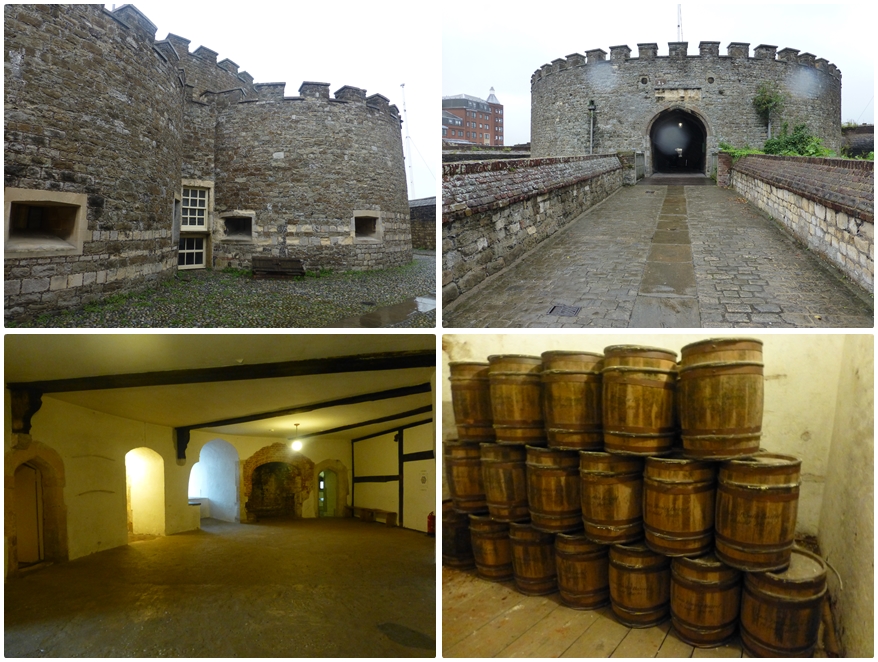| Back to Back Issues Page |
 |
|
Essentially England News - Keeping Guard March 05, 2017 |
Keeping GuardYay, it’s spring! On some days, at least, it feels like it. We have snow drops, crocuses, alpine violets and primroses. There’s jasmine and the first daffodils are getting ready to unfurl their petals. And just down the road from us, and always earlier than any others anywhere, there grows a clump of lilies. Just the other day I realised that I’ve photographed them every single spring while out walking, so amazed to find them thus early. Yes, it still gets cold and grumpy every now and then, but I think winter’s on the way out, and February is history.

Keeping GuardTalking of history, I promised to get back to the castles that dot England’s coast. In January, we had Walmer, the base of the Lords Warden of the Cinque Ports. Now we move a little way along the coast to one of Walmer’s two companions, Deal Castle.Like Walmer, Deal was built between 1539 and 1540 on the orders of King Henry VIII to help guard against the threat of a Spanish invasion. And it’s regarded as one of the finest artillery forts remaining from this period. It’s also the place where Anne of Cleves was entertained on her way to meet her future husband, Henry VIII. Things may have worked out better for her than for some of the other women the king’s eyes fell on, but I’m sure we can agree that being a royal bride was a rather hazardous job in Tudor times. Probably more hazardous than being one of the soldiers hired to man Deal Castle.
 Deal was no towering bastion dominating the landscape for miles around. Instead it huddled low to the ground, its shape hard to make out (and harder to hit) from seaward. Like other such forts it was formed of a squat, circular keep surrounded by half a dozen semi-circular bastions, giving it that traditional flower petal shape. Deal was constructed to mount 66 guns in four tiers, but during peacetime the garrison would have housed only 16-18 gunners, all sharing living quarters on the ground floor of the keep. Some would have been joined by wives and children, but they all earned about 6d a day in exchange for guarding the castle and keeping an eye on cargo retrieved from ships that were wrecked on the Goodwin Sands. This wasn’t the army as we know it today. And not just because of the communal living arrangements. Members of the garrison would occasionally seek work in town, or even live in Deal itself, and during wartime local recruits would be added to the garrison’s contingent. So I would imagine that the garrison’s fighting prowess was somewhat limited. The catering wasn’t up to modern restaurant standards either. When the Royalist garrison of Deal Castle surrendered to the Parliamentarians after a lengthy siege in 1648, the food stores listed bread, wheat, cheese, salt pork, salt beef, salt cod and a barrel of pease. And no, I wouldn’t fancy that all day every day either. Fortunately, Deal was never called upon to repeal an invasion fleet, but the strategic position of the three castles in the Downs - Deal, Walmer and Sandown - meant that it lived a long life as a garrison. Even if the great sea battle of that age, the fight against the mighty Spanish Armada, bypassed the castle, the gunners of Deal probably saw the glow on the horizon when the English fire ships decimated the Spanish at Dover. Both times we've spent a holiday there, Kent has been a real surprise for us. It's got more
historical houses, castles and gardens to explore than you can comfortably cram into a week. It has beaches and quiet woods for peaceful walks. It has sweet little market towns, tiny villages and wonderful food. And - in our opinion - the best way to explore Kent is from a holiday cottage. If that idea floats your boat, take a look at the ones we've collected here. All places where we wish we could stay... Orange CheerAnyone living in Spain, Florida or California may not understand this at all… but in old England, oranges used to be a real treat. Bitter Seville oranges and sweet oranges were at their very best when little else was, and while they were expensive, many families stretched the budget at least once for a lovely exotic treat. Rice pudding with marmalade and orange-flavoured cakes and biscuits were quite the rage, and if you start to look there’s a huge variety of orange puddings around too.This one is a recipe I found in Michael Barry’s Old English Recipes and it dates back to 1830. It appeals to me, since it is an orange custard and much lighter than the breadcrumb-laced puddings. It's made very much like a custard, too - only instead of the milk you use orange juice, and you serve it well chilled. If you want to make this at a time when Seville oranges are not in season, use two thirds sweet orange juice to one third grapefruit juice. Here’s what you need for the standard recipe:
Beat the egg yolks until light and foaming, then mix in the orange juice. Strain into a non-stick pan, glass bowl or double boiler. I used to make this in a bowl over a pan of water, but I’ve found that my ceramic hob goes low enough to use a non-stick pan. Basically, you want the temperature high enough to cook the eggs bit low enough not to scramble them. Stir in the sugar and warm the whole mix until the sugar melts. Keep stirring your custard until it thickens. When it coats the back of a spoon take it off the heat and stir in the butter. Leave your custard to cool a little, then spoon it into glass dishes and chill until ready to serve.
And Next Month …That's it from us for the moment. I'm thinking about moving along the coast to Sussex for the next of my castle tours. Or, alternatively, we could be taking a look at holiday accommodation with a Royal twist... just in case you're looking for a break with a difference. Meanwhile, keep warm, keep safe and I'll see you all next month....
And why not join us on Twitter or Instagram and LIKE us on Facebook? I'll be very happy to see you! P.S. If you think that some of your friends or colleagues might like to read our newsletter, then please forward them this mail. They can read newsletter back issues and subscribe here. |
| Back to Back Issues Page |